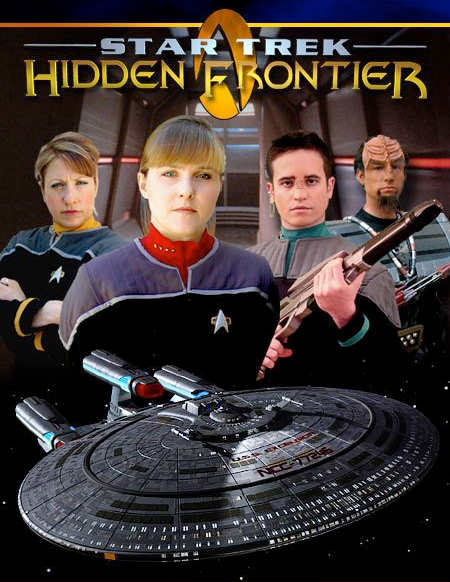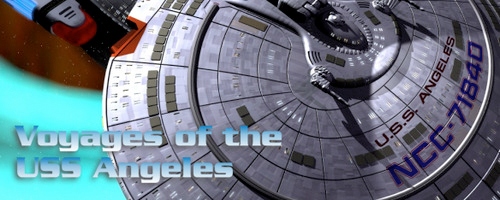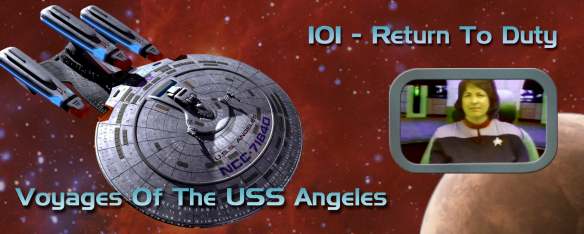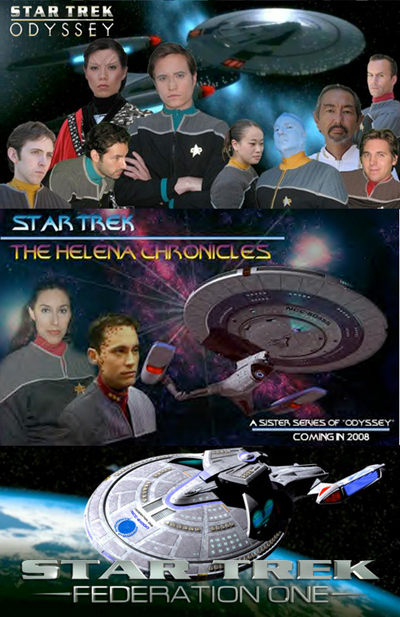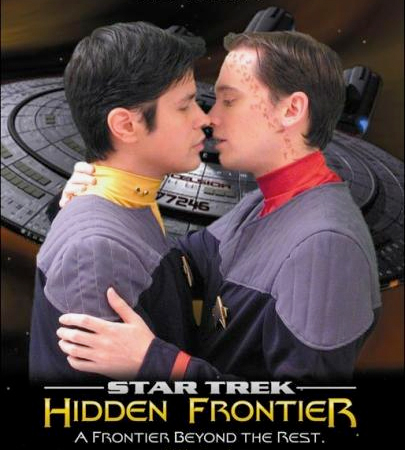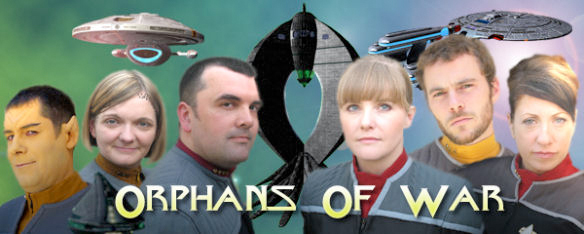As I mentioned in a few of my previous articles, the dawn of the “modern age of Star Trek fan films” arrived in the year 2000 with the release onto the Internet of Star Trek: Hidden Frontier. It was the quintessential fan film: Trekkie actors with little or no formal training, cheap store-bought or home-made costumes, zero budget, minimal sets, basic-level storytelling (that’s a euphemism for kinda sucky writing), and dubious sound and image quality.
But Hidden Frontier also had heart – a great deal of heart – plus a deep love for the franchise and determination to create fun and original Star Trek on a fan level.
When Hidden Frontier started, Star Trek was still going strong on TV (DS9 had just ended, but Voyager continued and Enterprise was about to begin), so this fan series wasn’t simply an attempt to cope with the loss of Star Trek from the airwaves (that was still five years away). Hidden Frontier was just fans getting together to make their own Star Trek. And before they were done a decade later, the “humble” Hidden Frontier would blaze a shining trail for future fan film efforts to follow.
The story of Hidden Frontier actually begins back in 1995 with the founding of the USS Angeles, a chapter of STARFLEET, the International Star Trek Fan Association. One of hundreds of local groups that formed the larger parent organization, the USS Angeles was based in southern California and included a number of members who both worked in Hollywood or wanted to work in Hollywood. One of these members was a young dynamo named Rob Caves, still a teenager but trying to make a name for himself in the industry. (Full disclosure: another Angeles member, both past and present, was and is your humble writer of this blog.)
By 1998, Rob was eager to use all the cool film equipment and new 3-D and video-editing software that had come down in price and gone up in quality. He invited his fellow “crewmates” to come over to his house and film a Star Trek movie called Voyages of the USS Angeles: The Price of Duty in front of green screens in his parent’s living room. Rob and fellow Angeles member Jason Muñoz wrote a script, Rob directed and produced along with the chapter president at the time, Janice Willcocks. Members would wear their own uniforms (or borrow them), and Rob would composite the “actors” against backgrounds acquired from “The Captain’s Chair” CD-ROM, which contained set photos of Enterprise-D interiors taken from multiple angles. In other words, we had an entire Galaxy-class starship to act in… as long as the camera angle didn’t move! We also did some on-location filming at Vasquez Rocks and in the San Gabriel mountains near Los Angeles.
To be honest, unless you were or are a member of the USS Angeles, that first effort wasn’t exactly what one would consider “must-see” Star Trek. In fact, the script was written to provide fun scenes for as many chapter members as possible, including kids and older folks… and even included a scene where I make out with my then-girlfriend in the turbo lift. (Yes, that really happened—and I cringe to watch myself all these years later. If you’re curious, though, fast-forward to the 15:10 mark…and don’t tell my wife!)
When all was said and done, Voyages of the USS Angeles was little more than a bunch of Trek fans having fun over a few weekends of filming… and heck, back in 1998, how many fan clubs produced their own 71-minute movie with special effects and music and virtual sets? Five additional episodes of the series were completed, each about 20-30 minutes.
But then Rob wrote a script that introduced the character of Artim, the Ba’ku boy from the movie Star Trek: Insurrection who befriended Data. Now remember that this was 1999, years before Star Trek: New Voyages went so far as to recast Kirk, Spock, and the rest of the TOS crew. Was it even allowed to use an established Trek character in a non- canon fan film? No one knew! And that made a few people a little nervous about potential repercussions from Paramount.
Rob actually had plans to add in other canonical Trek characters, but the head of the USS Angeles wasn’t comfortable producing such a fan film with the name of the club attached to it. Fair enough. So after some discussions, the Voyages of the USS Angeles series was phased out, and Rob launched Star Trek: Hidden Frontier as a production independent from the USS Angeles. Club members (including myself) still worked on the new episodes, both in front of and behind the camera, and the fresh, new series carried forward some of the characters and storylines from the previous one. But there was no official link to the fan club.
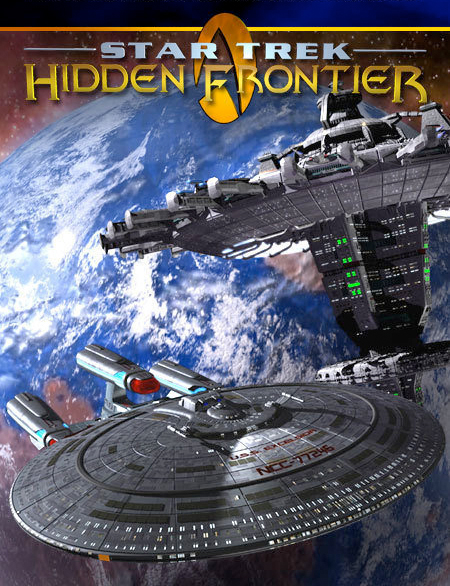
The episodes of Hidden Frontier were set in the time period following the Dominion War of the late 24th century and featured most prominently the starship USS Excelsior (a tri- nacelled dreadnought like the future Enterprise-D from “All Good Things”) along with other vessels based out of Deep Space 12, a Federation starbase located in the Briar Patch (from Star Trek: Insurrection).
Hidden Frontier would go on to produce SEVEN SEASONS of episodes over the next seven years for a total of FIFTY episodes of about a half hour each. In addition, Hidden Frontier spawned no less than FIVE spin-off series: Star Trek: Odyssey (with eight episodes plus a two-part finale over three seasons), Star Trek: The Helena Chronicles (with six episodes over two seasons), Star Trek: Federation One (with two video episodes in its first season and four audio episodes in its second), Star Trek: Diplomatic Relations (with four audio-only episodes), and Star Trek: Henglaar, M.D. (with eight audio episodes over two years).
Hidden Frontier also continued to recast and include established characters from Trek canon. In addition to Artim, Rob Caves made use of the prominent characters of Commander Elizabeth Shelby from TNG’s “The Best of Both Worlds” (promoting her to Captain), Robin Lefler (Wesley’s girlfriend from the TNG episode “The Game”), and Admiral Nechayev from multiple episodes of TNG and DS9. There were also relatives of established Trek characters, such as Ro Laren’s brother Ro Nevin and Jeremy Aster’s cousin Corey Aster.
After a few seasons, Hidden Frontier was beginning to spread out and catch on with Trek fans. Remember that Hidden Frontier began two years before the release of Starship Exeter and four years before the debut of Star Trek: New Voyages. So for most, Hidden Frontier was the only Trek fan film game in town for at least a couple of years, with episodes available via download… although cast and crew were given copies on DVD (or VHS) for free and some of these were copied and distributed by others. Rob himself was very careful to generate zero revenue from this project, fearing the wrath of Paramount (a.k.a Viacom, the Trek license holder at the time).
Hidden Frontier continued for a few years without Rob Caves hearing anything from Paramount or Viacom. Interestingly, James Cawley from Star Trek: New Voyages had been contacted by Paramount in 2003 with a list of dos and don’ts… even before his pilot episode was released! Among other things, James was told not to charge for the episodes and to not make any money from them. And indeed, Rob was following the same careful rule. But despite this “don’t ask, don’t tell” philosophy from Paramount at the time (and continuing generally until today), there was still a somber feeling among many fan films that they all needed to tread very carefully lest any of them become the foot that triggered the tripwire and ruined it for everyone.

So you can probably imagine the rock that landed in the pit of Rob Caves’ stomach when he received the following cease and desist letter in 2004…
The letter appeared to be completely legit. The New York law firm listed in the header really did exist, although the letter was postmarked from “Northridge, CA”… and that seemed a little odd. Perhaps the letter was just a prank from someone either trying to be funny or attempting to torpedo Hidden Frontier. Rob wasn’t taking any chances, though. He contacted Paramount.
Rob describes the phone conversation as somewhat awkward:
I was connected right away with someone and explained I had received this cease and desist. She politely explained it was not sent from their office and that no Paramount communication would ever be postmarked from Northridge, California (the Paramount studios and offices are in LA proper on Melrose Ave.), although the legal office was indeed in New York City.
I distinctly remember playing the “just a huge fan of Star Trek” line and probably fell over my words saying something like, “We love Star Trek and would never do anything to damage it, and we’re not making any money. We just want to keep having fun in your sandbox.” And as soon as I knew for sure that it was a phony cease and desist letter, I really didn’t want to take up any more of her time. She thanked me for the call, but there really wasn’t anything else substantial to the conversation… just me stumbling over myself to cover an awkward situation. There were no warnings given or guidelines set out.
And so the sandbox of Star Trek fan films remained safe to play in. Hidden Frontier continued onward, completing more than ten years of continuous production for nearly 25 hours of original Star Trek on video and several more hours on audio. And while other fan films may have leapfrogged Hidden Frontier in terms of overall production value and quality, no other fan film series has even come close to delivering so much content to viewers so consistently over such an extended period of time.
And remember that Hidden Frontier was produced almost entirely in the days before crowd-funding, where budgets were typically counted out with dollar bills and loose change to tip the pizza delivery guy. Despite all this, Hidden Frontier broke new ground and set many precedents in the history of fan films.
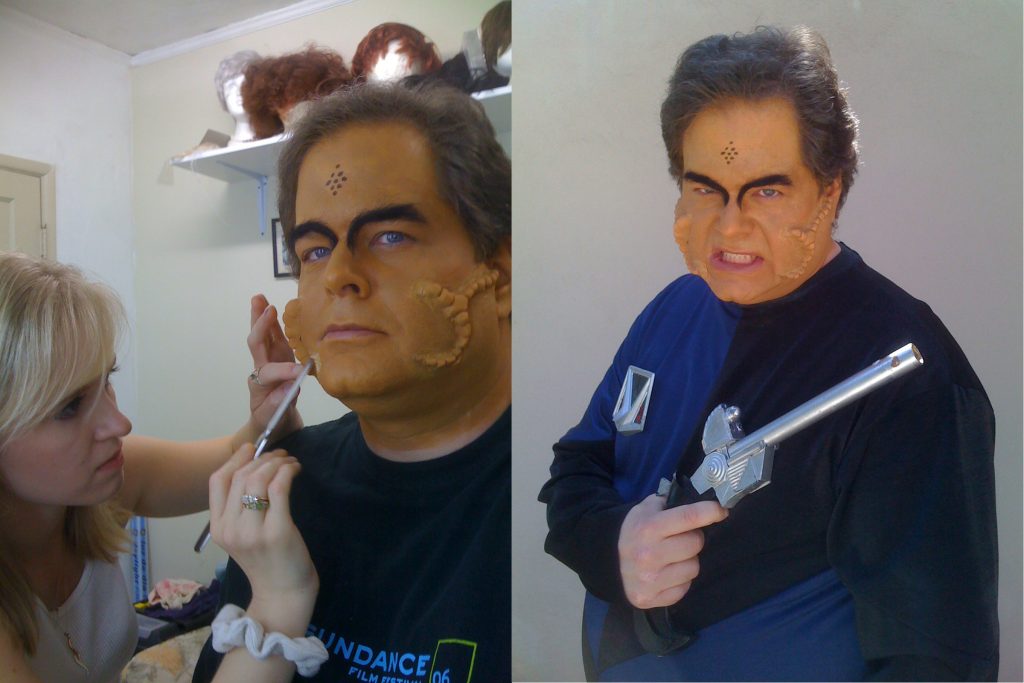
One of the most obvious precedents, certainly the easiest to see, was an extensive array of alien races throughout most of their episodes. In the early days of fan films, while aliens weren’t unheard of, they were usually rare because of the make-up challenges involved. You’d see Vulcans and Romulans (the easy ones), Klingons, because many fans already had their own prosthetics, and Starship Exeter featured an Andorian. But utilizing the skills of accomplished make-up artist John Whiting (who also played the Tellarite, Dr. Henglaar, on the series), Hidden Frontier featured Vulcans, Romulans, Cardassians, Breen, Klingons, Trill, Orions, Andorians, Tellarites, Bolians, and even a few never-before-seen races. I actually played one of these new aliens in an episode from 2008. Take a look…
Hidden Frontier was also the first Trek fan film of the “modern age” to use professional actors to play some of the parts. (Technically, Yorktown: A Time to Heal did it earlier in 1985 with George Takei, but that fan film was never completed back then.) Granted, Hidden Frontier never went so far as to hire veteran actors who had previously appeared on Star Trek or in other sci-fi franchises, but Rob Caves did reach out to trained actors in the L.A. area looking to hone their skills and expand their resumes. Eventually, Hidden Frontier developed a cast mixed with both non-actor fans and trained actors. The result is that the series quality and watchability improved dramatically beginning in the third and fourth seasons.
Another interesting precedent came with the inclusion of gay characters. Years before Star Trek: New Voyages/Phase II introduced a storyline involving gay characters in love in their two-part episode “Blood and Fire”, Hidden Frontier featured not one, not two, but three recurring homosexual and bi-sexual officers over the course of the series.
A notable tidbit is that Hidden Frontier was the first fan film series to do a full crossover with another fan series, Star Trek: Intrepid out of Scotland. In late 2007, the two productions jointly released the 12-minute crossover film Orphans of War featuring the crews of both the dreadnought Excelsior from HF (and the new spin-off series Odyssey) alongside the USS Intrepid. Technically, ten months earlier, Starship Farragut had done a crossover event with Star Trek: New Voyages where Kirk, Spock, and McCoy briefly appeared on the viewscreen of the Farragut’s bridge giving Captain Carter an encouraging sendoff. But that was a brief cameo, and Orphans of War was a full-on crossover. Hidden Frontier was also the first fan film series to spawn full spin-off series (five in total!).
And finally, Hidden Frontier was the first fan film series to hold its own annual convention – three in fact – in 2006 through 2008. Since then, Farragut Films in Georgia, Retro Studios in upstate New York, and Starbase Studios in Oklahoma has opened their TOS sets to the general public, and Alec Peters is planning to host AxaCon at Ares Studios sometime next year. The Excelsior Ball, as it was called, had attendance of about 150 fans plus cast and crew and took place at an L.A. hotel. It wasn’t huge, but it allowed the most passionate of the series supporters to show their appreciation for the dedication of the production team.
Next week, I’ll present a lively interview conducted with the Hidden Frontier creator himself, Rob Caves, full of interesting behind-the-scenes information and insights.
In the meantime, if you haven’t ever seen an episode of Hidden Frontier and find yourself curious (or if you have and just feel like watching it again), take a look at or listen to any of the nearly 70 offerings located on their website.
(Feel free to skip the first two seasons of Hidden Frontier and all of Voyages of the USS Angeles. Trust me! Everything else is decent, and some episodes are even quite good! Excelsior!!!)
Here is a direct link to just the seven seasons of Hidden Frontier.
Ratings vary by episode, but in general:



Seasons 1 and 2 – DECENT EFFORTSeason 3 – PRETTY GOODSeasons 4 thru 7 –HIGHLY RECOMMENDED

